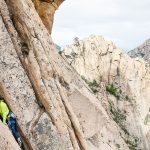
 Allow others a sense of discovery by leaving rocks, plants, archaeological artifacts and other objects of interest as you find them.
Allow others a sense of discovery by leaving rocks, plants, archaeological artifacts and other objects of interest as you find them.
Minimize site alterations. On all sites, leave the area as you found it. Do not dig trenches for tents or construct lean-tos, tables, chairs or other rudimentary improvements. If you clear the area of surface rocks, twigs or pinecones, replace these items before leaving. On high-impact sites, it is appropriate to clean up the site and dismantle excessive user built facilities, such as multiple fire rings and constructed seats or tables. Consider the idea that good campsites are found and not made.
Single, properly-located legal fire rings, should be left intact for others to use. Dismantling them will cause additional impact, because in all probability they will be rebuilt with new rocks.
Avoid damaging live trees and plants. Avoid hammering nails into trees for hanging things, hacking at them with hatchets and saws, or girdling trunks with tent lines. The cutting of boughs for use as a sleeping pad creates minimal benefit and maximum impact. Inexpensive sleeping pads are readily available at stores catering to backcountry travelers.
Take a picture or sketch flowers instead of picking them. Enjoy an occasional edible plant, but be careful not to deplete the surrounding vegetation or to disturb plants that are either rare or do not reproduce in abundance.
Leave natural objects and cultural artifacts. Natural objects of beauty or interest, such as antlers or fossils should be left for others to discover and enjoy. In National Parks and some other areas it is illegal to remove some natural objects.
The same ethic is applicable to the discovery, disturbance or removal of cultural artifacts found on public land. Cultural artifacts are protected by the Archaeological Resources Protection Act, and it is illegal to remove artifacts from ANY public lands. This act protects all artifacts ranging from seemingly insignificant pot shards and arrowheads to ornate pots or clothing items.



